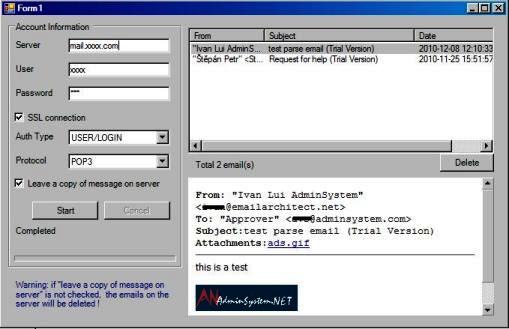Parse Email Body, Attachment and Convert Email to HTML page in Delphi¶
In previous section, I introduced how to parse winmail.dat. In this section, I will introduce how to parse email body and attachment, then convert email to a HTML page and display it using Web browser in Delphi.
Introduction¶
After the email was converted to HTML page, you can browse it with web browser. You can get everything in the HTML page such as From, To, Cc, Subject, Date, Attachments and Embedded images.
Note
Remarks: All of examples in this section are based on first section: A simple Delphi project. To compile and run the following example codes successfully, please click here to learn how to create the test project and add reference to your project.
[Delphi Example - Convert email to HTML]¶
The following example codes demonstrate how to use EAGetMail POP3 component to convert email to HTML page.
Note
To get the full sample projects, please refer to Samples section.
unit Unit1;
interface
uses
Windows, Messages, SysUtils, Variants, Classes, Graphics, Controls, Forms,
Dialogs, StdCtrls, StrUtils, EAGetMailObjLib_TLB;
type
TForm1 = class(TForm)
Button1: TButton;
procedure Button1Click(Sender: TObject);
private
{ Private declarations }
procedure ConvertMailToHtml(fileName: WideString);
procedure GenerateHtmlForEmail(emlFile: WideString; htmlFile: WideString; attachmentFolder: WideString);
function FormatAddresses(addresses: IAddressCollection; prefix: WideString): WideString;
public
{ Public declarations }
end;
const
CRYPT_MACHINE_KEYSET = 32;
CRYPT_USER_KEYSET = 4096;
CERT_SYSTEM_STORE_CURRENT_USER = 65536;
CERT_SYSTEM_STORE_LOCAL_MACHINE = 131072;
Var
Form1: TForm1;
Implementation
{$R *.dfm}
procedure TForm1.ConvertMailToHtml(fileName: WideString);
var
htmlFile, attachmentFolder: WideString;
oTools: TTools;
begin
// Remove .eml extension
htmlFile := LeftStr(fileName, length(fileName) - 4) + '.htm';
attachmentFolder := LeftStr(fileName, length(fileName) - 4);
oTools := TTools.Create(Application);
if not oTools.ExistFile(htmlFile) then
begin
// We haven't generate the html for this email, generate it now.
GenerateHtmlForEmail(fileName, htmlFile, attachmentFolder);
end;
end;
procedure TForm1.GenerateHtmlForEmail(emlFile: WideString; htmlFile: WideString; attachmentFolder: WideString);
var
oMail: TMail;
oTools: TTools;
attachments: IAttachmentCollection;
oAttachment: IAttachment;
i: integer;
html, header, attachmentName: WideString;
begin
oTools := TTools.Create(Application);
oMail := TMail.Create(Application);
oMail.LicenseCode := 'TryIt';
oMail.LoadFile(emlFile, false);
try
if oMail.IsEncrypted then
oMail.Load(oMail.Decrypt(nil).Content);
except
on ep:Exception do
ShowMessage('Decrypt Error: ' + ep.Message);
end;
try
if oMail.IsSigned then
oMail.VerifySignature();
except
on ep:Exception do
ShowMessage('Verify Digital Signature Error: ' + ep.Message);
end;
// Decode winmail.dat (TNEF stream) automatically.
// also convert RTF body to HTML automatically.
oMail.DecodeTNEF();
html := oMail.HtmlBody;
header := header + '<font face="Courier New,Arial" size="2">';
header := header + '<b>From:</b> ' + oMail.From.Name + ' <' + oMail.From.Address + '>' + '<br>';
header := header + FormatAddresses(oMail.ToList, 'To');
header := header + FormatAddresses(oMail.CcList, 'Cc');
header := header + '<b>Subject:</b>' + oMail.Subject + '<br>' + #13#10;
// Parse attachment
attachments := oMail.AttachmentList;
if(attachments.Count > 0) then
begin
// Create a temporal folder to store attachments.
if not oTools.ExistFile(attachmentFolder) then
oTools.CreateFolder(attachmentFolder);
header := header + '<b>Attachments:</b> ';
for i:= 0 to attachments.Count - 1 do
begin
oAttachment := attachments.Item[i];
attachmentName := attachmentFolder + '\' + oAttachment.Name;
oAttachment.SaveAs(attachmentName, true);
header := header + '<a href="' + attachmentName + '" target="_blank">' + oAttachment.Name + '</a> ';
// Show embedded images
if oAttachment.ContentID <> '' then
begin
// StringReplace doesn't support some non-ascii characters very well.
html := StringReplace(html, 'cid:' + oAttachment.ContentID, attachmentName, [rfReplaceAll, rfIgnoreCase]);
end
end;
end;
header := '<meta http-equiv="Content-Type" content="text-html; charset=utf-8">' + header;
html := header + '<hr>' + html;
oTools.WriteTextFile(htmlFile, html, 65001);
end;
function TForm1.FormatAddresses(addresses: IAddressCollection; prefix: WideString): WideString;
var
value: WideString;
i: integer;
begin
if addresses.Count = 0 then
begin
result := '';
exit;
end;
value := '<b>' + prefix + ':</b> '; // To or Cc
for i := 0 to addresses.Count - 1 do
begin
if(addresses.Item[i].Name = '') then
value := value + '<' + addresses.Item[i].Address + '>'
else
value := value + addresses.Item[i].Name + ' <' + addresses.Item[i].Address + '>';
if (i < addresses.Count - 1) then
value := value + '; ';
end;
result := value + '<br>';
end;
procedure TForm1.Button1Click(Sender: TObject);
begin
try
ConvertMailToHtml('c:\my folder\test.eml');
except
on ep:Exception do
ShowMessage('Error: ' + ep.Message);
end;
end;
end.
In EAGetMail installer, there are many samples demonstrate how to use Web browser control to display the email, I suggest that you download it and have a try

Next Section
At next section I will introduce how to parse Non-delivery report.
Appendix
- EAGetMail POP3/IMAP4 Component SDK
- Using UIDLManager to mark email as read/downloaded
- Download only unread/new emails from IMAP or MS Exchange Server
- Search emails and filter emails on IMAP or MS Exchange Server
- Retrieve emails from specified folder in IMAP or MS Exchange Server
- Parse Outlook .MSG file
- Registration-free COM with Manifest File (Distribution).
Comments
If you have any comments or questions about above example codes, please click here to add your comments.
